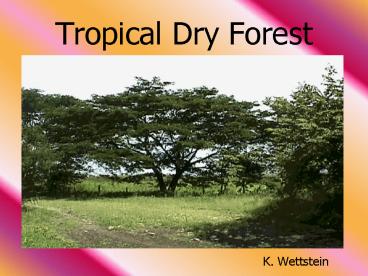Tropical Dry Forest - PowerPoint PPT Presentation
1 / 10
Title:
Tropical Dry Forest
Description:
Bobcat. Mountain lion. Ocelot. Food Chain. Energy from sun. First tropic level: Producers ... gophers, rabbits, coyotes, foxes, raccoons, badgers, and bobcats. ... – PowerPoint PPT presentation
Number of Views:1587
Avg rating:4.0/5.0
Title: Tropical Dry Forest
1
Tropical Dry Forest
- K. Wettstein
2
Imperative Information
Temperature Temperatures are high all year the
average temperature is above 24C Because of its
proximity to the coast, fluctuations in annual
temperatures are only 10-15 C Frost and
temperatures below freezing are rare Temps. have
been recorded as low as 3C and as high as 31C
The air changes from moist due to inter-tropical
region mixtures in the summer to the dry air
because of a subtropical weather front during the
winter
Precipitation The dry season is far longer than
the brief period of rainfall There is no set
amount of rain, it depends on the area Annual
rainfall is anywhere from 10-20 cm to 1000 1500
cm per year depending on the specific tropical
dry forest There is decreasing summer
precipitation
Solar Isolation Seasonal alternation A well
defined dry season, but a short wet season in
comparison to a tropical rain forest The dry
season typically lasts from June through August
Limiting Factors Its well defined dry season
limits plant growth and the activity of
animals A large soil-water shortage occurs,
especially severe during the hottest time prior
to the rains
3
Species Diversity
- Plant Life
- Most of the trees and shrubs found in this type
of habitat are deciduous, losing their leaves at
beginning of the dry season - Leaves shed in dry season to conserve soil
moisture. - Up to 40 tree species in small forests
- Dry forests consist of trees, shrubs, and
undergrowth of different heights which form a
canopy - Lotus, ironwood, and acacias
- Columnar, jumping cholla and barrel cactus
- More light penetration and more understory
vegetation than a tropical rain forest
- Animal Life
- Tasmanian devil
- American alligator
- Merriam's Kangaroo rat
- Ants
- Lizards
- Shrews
- Coyotes
- Kit and gray foxes
- Ringtails
- Raccoons
- Skunks
- Badger
- Bobcat
- Mountain lion
- Ocelot
4
Food Chain
Energy from sun
First tropic level Producers
Second tropic level Primary consumers
Third tropic level Secondary consumers
Fourth tropic level Tertiary consumers
Decomposers
heat
heat
heat
heat
heat
5
Interesting Facts
It may come as a surprise that for over 75 of
the tropics, annual drought is a way of life. Dry
tropical forests are also heavily logged, and are
nearly vanished in Indonesia. There is really no
actual distinction between this zone and the
tropical rain forest. Because the length of the
dry season varies tremendously throughout the
tropics, one biome gradually changes into the
other over hundreds of miles. Wetter or drier
soils sometimes produce pockets of tropical dry
forest within a tropical rain forest.
6
Tropical Dry Forests
Richard Chen IB Env. Science
7
Climate / Seasons Tropical dry forests have
a seasonal climate, alternating between a wet and
dry season. However, the dry season is often
longer than the wet season, lasting over five
months every year.
Geography Located from 10º to 25º N and S.
Temperature The annual mean temperature is
approximately 81ºF, or around 27ºC. However, in
the dry season, this may increase to 99ºF, or
37ºC.
Precipitation The annual rainfall is usually
around 150-200 cm.
Sunlight Trees are not as close to each
other as in a rain forest, therefore allowing
more sunlight to reach the forest floor.
Soil The soil in this area is richer with
nutrients, but is more vulnerable to erosion.
Limiting Factors of the Biome The fact that
the dry season lasts longer than the wet season,
as well as the soils high susceptibility to
erosion, limits the growth of certain plant life.
This, in turn, will limit the biomes ability to
sustain animal life.
8
Species Diversity
The majority of the biomes fauna is deciduous,
meaning these plants shed their leaves at the
onset of the dry season in order to prevent
excess water loss. Other species of plants store
water in their fleshy leaves or stems, or simply
have thick waxy skins, such as cacti.
Types of plants deciduous shrubs, cacti,
deciduous trees, and legumes.
Decomposers such as mold and fungi work during
the brief wet season to break down waste into
nutrients.
Animals in the tropical dry forest have adapted
to survive in the arid, dry seasons. Many
animals are nocturnal, gathering their food in
the cooler night, conserving water. Insects can
readily survive in these conditions, and provide
a source of food for larger animals.
Types of animals desert deer, cactus and pocket
mice, wood and kangaroo rats, lizards, gophers,
rabbits, coyotes, foxes, raccoons, badgers, and
bobcats.
9
Food Chain
Sun
Jackrabbit
Coyote
Deciduous shrubs
Ants
Fungus
10
Facts
Since dry forest is suitable for agriculture,
much of it has been burned to make way for
farmland.
The high productivity during the wet season, as
well as the relief from rain during the dry
season makes this a favorable area for humans to
clear in order to be developed for agricultural
needs.
Tropical dry forests make up the majority of
tropical forests on the earth. Even though they
are more endangered than rainforests in some
areas, public awareness is still at a minimal.































